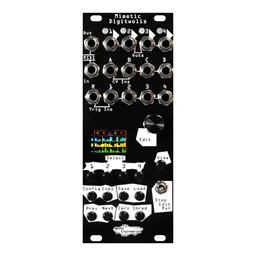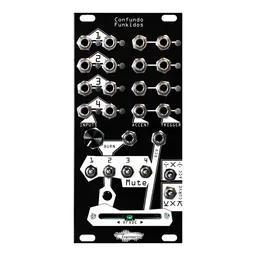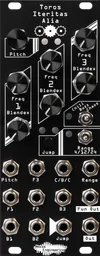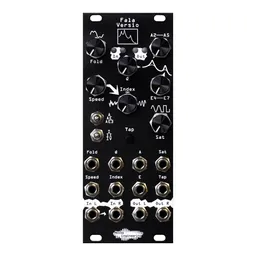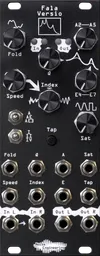New Firmware Season continues: last week we introduced Ampla Legio, and this week it’s time for Fala Versio. Fala Versio is a stereo formant filter with, as usual, quite a few twists, so this week we’ll be exploring what it can do and how it works.
Fala Versio is available to purchase now. If you’re a Versio owner and you’d like to try it out right away, head on over to the firmware swap app to load it onto your module.

Formants and beyond
Fala Versio takes the classic concept of a formant filter, and goes in a new direction. Instead of attempting to recreate vowel sounds, Fala imparts a vocal quality on any sound run through it while retaining musicality. One, two, or three formants can be used to process a sound, with adjustable resonance that goes from gentle to squelchy. Fala was also carefully tuned to be as gnarly or as nice as you want it to be: with resonance and all distortion parameters turned down the resulting sounds are downright beautiful. But with some pre-filter Fold and post-filter Saturation, things can get incredibly grimy.
Fala has a number of completely unique features, too. We wanted it to be able to process anything, so there is a set of allpass filters at the input that prime any signal for further processing. The input wavefolder plays double duty: wavefolders are, of course, awesome, and allow for some pretty incredible distortion. In this case, though, it also allows for the careful addition of some extra harmonics if your input signal is relatively clean – think a pure sine wave or an 808 kick. Some extra top-end allows the formant filter to sound even better, so distorting pre-filter, while unusual, adds a lot of options in Fala.
Of course, we couldn’t stop with just one distortion. Each formant has its own saturator, which can add some serious grit when the Sat parameter is cranked. With certain settings, 12 independent saturators are active in the Fala signal path. If you want distortion, it’s there for you!
Many Versio firmwares feature internal modulation, and Fala is no exception. Fala features a tap-tempo LFO that can be synced to an external clock. Adding in some internal modulation opened up some cool possibilities for playing with the stereo field: the bottom switch on Fala allows up to four copies of the formant filters to be stacked on top of each other, and each formant can be individually modulated by its own correlated LFO. The LFOs modulate the formants in stereo, adding some intense animation to the signal. There’s a smooth sinusoidal waveform or a random, less-correlated noise wave that can modulate the filters.
And if that’s not enough modulation for you, Fala has seven CV inputs! Isn’t modular wonderful?
The backstory
Fala has been an idea of ours for a long time. Formant filters are a lot of fun to play with, and we’ve made quite a few attempts at creating them in some form or another. About a year and a half ago we decided that making one for the Versio would be a great addition to the platform, and we dug into development.
This was initially the baby of Adam, one of our software engineers, and was to be his first embedded project. He spent a fair amount of time researching the classic formant shapes, and even looked into biological filters a bit with some pointers from Kris (think how a non-human animal’s vocal tract shapes its sound…much like it does in humans).
All this led to uninspiring results: they sounded cool, but they also sounded very familiar. And then Adam left NE and Fala got shelved for a bit.
Fast forward to this winter when we decided to get a firmware for each platform out in one month (there may have been a misguided attempt at a ridiculous Advent calendar at the start of that conversation). We dusted off Fala and decided to go in a bit of a different direction, and after quite a bit of refinement we ended up with a few sets of formants… and after even more testing landed on the layout that you hear today.
After the filters were sorted out, we started exploring different distortion options. Initially, we had a wavefolder followed by a saturator, but it didn’t give us quite the timbral range that we wanted: things got too noisy too fast. We first tried limiting the range of the wavefolder, but, let’s be real, that’s no fun at all, so we started experimenting with the order of processing instead. To our surprise, putting the wavefolder before the filter gave us the best results!
The final sticking point was the LFOs: just modulating the filter cutoffs with a single LFO didn’t sound as nice as we expected, and using the random LFO shapes we’d implemented in previous modules sounded downright cartoony. We started playing with more complex schemes, eventually implementing individual LFOs for each formant that could also work in stereo. The waveforms were quite simple, and we dialed them in to perfectly animate the stereo field just how we wanted. Using internal modulation allowed us to do a lot more than would be possible with external modulators (imagine patching up 18 phase-offset LFOs!) but didn’t give us quite the patch integration that we were hoping for. As a way to remedy this, we implemented the tap-tempo feature as a way to link the modulation with the rest of the patch.
We love how it turned out, but Fala took longer to develop than any other Versio firmware to date, had more people working on it than any other firmware, and was reconfigured more than any of them. It’s a good reminder that sometimes, it takes a few attempts and a couple of “should we start over from scratch?” moments to make progress. Fun fact, though: it’s not the one that’s been reimagined the most. That honor goes to [REDACTED].
